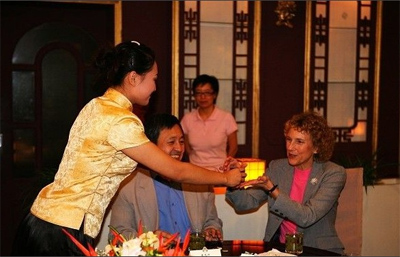
Chinese gourmet foot diplomacy has a a long history Southwest Silk Road was earlier than Northwestern Silk Road, which was started from the southwestern city of Chengdu, through Yunnan to reach the Indochina Peninsula Myanmar and India. This Silk Road also played the role of external communication food culture during the Han Dynasty. At that time, a large number of officers from Han dynasty were living in Jiaozhi, and the Dragon Boat Festival was introduced to Jiaozhi. So far Vietnam and Southeast Asian countries retained the custom of eating zongzi. Chinese diet culture has a very big impact on North Korea, and this situation is probably began in the Qin Dynasty. At that time, many residents came to North Korea, and the Chinese food culture was naturally brought to North Korea. The Chinese Wiman had ever been a king in Korea at the time of the Han Dynasty, Chinese diet culture has a very big impact on Korea at that time. Koreans are accustomed to using chopsticks, and the cooking ingredients and diet arrangement significantly have Chinese characteristics.
Chinese diet culture has biggest impact on Japan. In the middle of the 8th century, the Tang Dynasty monk Jian Zhen went to Japan, brought a lot of Chinese food, such as dry pizza, dry Zhengbing, Hu cake, pastries, as well as tools and technology. The Chinese desserts were called Guozi by Japanese, and learned to imitate. There were more than 20 kinds of Tang fruit was able to buy in the Japanese market at that time. Jianzhen also put the Chinese food culture to Japan, Japanese used chopsticks which were influenced by the Chinese. In Tang Dynasty, the Japanese students in China almost brought all food cultures to their countries, such as drink Su Tu wine in New Year, eat seven kind of vegetables in the first month of the seventh day, Shangsi pendulum Qushui feast in March, drink calamus wine on May fifth, drink chrysanthemum wine on September ninth day and so on. After the Dragon Boat Festival was introduced in Japan, the Japanese made ??some improvements according to their own eating habits, and developed a number of varieties, such as congratulation rice-pudding, the yee rice-pudding, the GE rice-pudding, Asahina rice-pudding and so on. In Tang Dynasty, Japan also imported noodles, steamed buns, dumplings, ravioli and made ??sauce method and so on from China. Japanese seasoning soy sauce, vinegar, tempeh, red yeast rice and tofu, sour balls, prunes, sake are derived from the Chinese. It is interesting that Japanese called miso for the Don sauce, broad beans for Don Cowpea, pepper for capsaicin, radish for Karamono, peanut for Nanjing beans, and Tofu skin for soup skin.
In addition to the Northwest Silk Road and Silk Road in Southwest, there is a Marine Silk Road, and it expanded the effect of Chinese food culture in the world. Thailand is located in the hub of the Maritime Silk Road, with convenient land transportation, so there were many bilateral exchanges. Thai people exchanged with Chinese frequently since the Tang Dynasty. From the 9th to the 10th century, a large number of residents from Guangdong, Fujian, Yunnan and other places emigrated to Southeast Asia, many of whom settled in Thailand, Chinese diet culture had biggest impact for the local people, it has a lot in common with China including Thais grains, noodles, tempeh, dried meat, sausage, pickled fish, spoon. Before the Chinese ceramic was incoming Thailand, the locals often used multi-plant leaves as tableware. With the introduction of Chinese porcelain, the locals have beautiful and practical dining utensils, the life and customs of the local residents which makes a big difference. At the same time, the Chinese immigrants also brought the production technology of sugar, tea, soybean processing to the Thailand, to promote the development of the local food industry. Chinese diet culture also has impact on Myanmar, Laos, Cambodia and other countries, of which Myanmar is more prominent. At the beginning of the 14th century, the Yuan army went into Myanmar, stationed for 20 years. At the same time, many Chinese businessmen were residing in Myanmar, had brought great changes to the locals eating life. Because most of these Chinese businessmen came from Fujian, so noun related to food culture in Burmese, which were spelt from Fujian dialect, like chopsticks, tofu, lychee, fried cypress, fritters and more. Several Southeast Asian island nations were affected by Chinese culture which was a little far away from China, like the Philippines, Malaysia and Indonesia. Filipino imported cabbage, spinach, celery, lettuce, peppers, peanuts, soybeans, pears, persimmons, citrus, pomegranate, peach, banana, lemon and other vegetables and fruits from China, Filipinos also love to eat Chinese meals, such as wonton noodle, Fajitas, buns, meat offal, roast suckling pig, and the daily diet cannot be separated from rice flour, dry surface, dried tofu, tempeh, the cookware is also Chinese-style pot and the small fry pan. Filipinos especially love to eat zongzi, they not only eat it in Dragon Boat Festival but also in Christmas, they also eat them as snacks in daily life, Philippines zongzi is long which was in accordance with the ancient Chinese system, the taste much like zongzi in Jiaxing, Zhejiang. Malaysia is also influenced by Chinese food culture. According to research, the ancestors of the Malaysian came from Yunnan who had ever planted rice, and some food customs of Malaysian have great relationship with these ancestors. For example, the Malaysian rice from planting to harvest has similar ritual activities and rituals of ancient China. Cooking methods of Malaysian food are similar with Chinese. The Chinese tofu which was called Taff by Malaysian was very loved by the people, some places also put the color, smell and taste of tofu into the local traditional curry. The effect of Chinese food culture has a long history to Indonesia. The Chinese immigrants who came to Indonesia offered technologies such as wine, tea, sugar, oil extraction, paddy fields and fish to the locals, and Chinese soybeans, lentils, mung beans, peanuts, tofu, bean sprouts, soy sauce, fans rice, noodles were introduced to Indonesia, has greatly enriched the life of the locals eating Tea has biggest impact on most countries in the world as an important part of Chinese food culture. The pronunciation of "Cha" and "Chaye" were evolved from the Chinese in the national language. Chinese tea has changed the dietary customs of many foreigners, for example, due to China's tea, the British developed the habit of drinking tea, and the Japanese formed unique "Chadao" because of the Chinese tea.
|

